Francistown
| Francistown | |
|---|---|
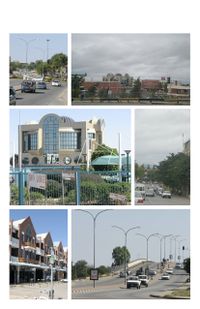 |
|
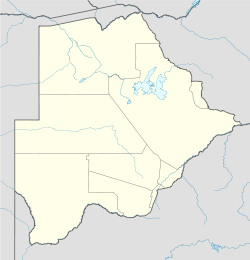 Francistown
|
|
| Coordinates: | |
| Country | Botswana |
| District | North-East |
| Founded | 1897 |
| Government | |
| - Mayor | Shadrack Nyeku |
| Elevation | 1,001 m (3,284 ft) |
| Population (2006)[1] | |
| - Total | 85,363 |
| Time zone | Central Africa Time (UTC+2) |
| - Summer (DST) | not observed (UTC+2) |
| Geographical area code[2][3] | 2XX |
Francistown is the second largest city in Botswana, with a population of about 85,363[1], and often described as the "Capital of the North". It is located in eastern Botswana, about 400 kilometres (250 mi) north-northeast from the capital, Gaborone. Francistown is located at the confluence of the Tati and Inchwe rivers, and near the Shashe River (tributary to the Limpopo) and 90 kilometres from the international border with Zimbabwe. Francistown was the centre of southern Africa's first gold rush, and is still surrounded by old and abandoned mines.
Contents |
History
Although evidence of habitation by humans goes back around 10,000 years, written evidence is more recent. The Ndebele came through the area in the 1830s on their way to Bulawayo, bringing their culture and influence to the Kalanga area of north-eastern Botswana. Reportedly, Nyangabgwe was the nearest village to Francistown to have been visited by Europeans, when it was visited by Robert Moffat. Moffat was followed in 1867 by a gold prospector, Karl Mauch who found gold along the Tati River.
The present town was founded in 1897, as a settlement near the Monarch mine and named after Daniel Francis, an English prospector who acquired prospecting licences in the region in 1869. Francis was a director of the Tati Concessions Company, who owned all the land in the settlement. The centre of the new town was formed when the company sold off 300 lots in August of that year. The Monarch mine was not the only mine in operation at that time, and it was widely believed that Francistown would grow rapidly.
In the beginning, the town comprised one street east of, and parallel to the railway line. This street featured a several companies, including a hotel, retail and wholesale shops and three banks. Behind these were the houses of the few white settlers. Segregated areas were made for mixed race and black people in the satellite township and between the railway and the river respectively.
After Botswana gained its independence in 1966, Francistown was no longer segregated.
In 1997 the town became a city, being the second largest city of the country.
Economy
Mining
Francistown is located on Botswana's main air and road transport routes; mining and agriculture are important. Principal mining companies include Tati Nickel, owned by Norilsk Nickel, which has operations at the Selkirk Mine and Phoenix Mine, producing principally cobalt, copper and nickel.[4] The Dumela Industrial Complex, an industrial park, is an important employer; the Botswana Metal Refinery was being built in 2008 near the city. However, the project was halted due to high costs.[5]
Media
Francistown media includes Botswana's The Voice newspaper.
Demographics and health
The Bakalanga, the second largest ethnic group in Botswana are traditionally centred around the town and the surrounding area. Recently, the city has seen a large influx of illegal immigrants from neighbouring Zimbabwe.[6][7]
Culture and tourism
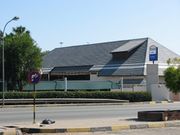
Francistown is home to the Supa Ngwao Museum, with exhibits related to the area's history and heritage. A new nature reserve, Tachila, has been established 5 kilometres (3.1 mi) from central Francistown on an old Tati Company Farm, Lady Mary. Construction of a lodge and accommodation is underway as of 2008.
Religion
The city is the home of the Cathedral of Our Lady of the Desert, which is the seat of the Apostolic Vicariate of Francistown. Francistown is home to several hotels like Cresta Thapama, Marang which can provide stopover accommodation for tourist traveling through the city.
Education
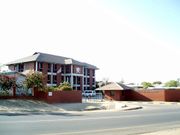

The Francistown Teacher Training College became one of the campuses of the University of Botswana in 1973.[8] Francistown Senior Secondary School opened in 1978 and currently enrolls 1200 students.[9]
The Francistown College of Technical and Vocational Education officially opened by President Ian Khama on 10 October 2008. The college was built in order to accommodate 1,500 learners on technical and vocational courses and teacher-training programmes. The college buildings are situated amongst a 4-hectare (9.9-acre) area. It also hosts the Institute of Health Sciences, which is near the Nyangabwe Hospital.
Transport and Infrastructure
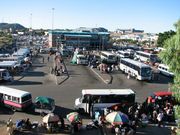
The city is a major transport hub. A railway line links the city with Harare in Zimbabwe via Bulawayo. The same line links Francistown with Gaborone in the south. Surfaced roads link the city to Lobatse in the south, and Ramokgwebana in the north, and to Kazungula via Nata.
The city is served by Francistown Airport, a domestic airport with two runways located around 2 kilometres (1.2 mi) from the city. In 2003, it had a total passenger throughput of 29,223. Currently, another airport is under construction. It has a larger capacity and is expected to replace the current airport.
Malls and Plazas
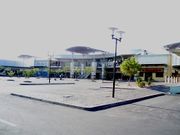
- Francistown/New Mall
- Blue Jacket Shopping Centre (Shoprite Complex)
- Blue Jacket Square (Supreme Furnishers Complex)
- Barclays Plaza
- Nzano Center
- The Village Mall (Diggers Inn)
- Galo Shopping Centre
- Golden Valley Mall (Marang Superspar Complex)
- Nswazwi Shopping Centre
Sports
There are several footbal clubs from Francistown. These include TAFIC, TASC FC, ECCO City Green, Great North Tigers and others. The first three play in Botswana Premier League while GNT and the rest play in lower divisions. Francistown Stadium is still under construction and will be complete soon. The stadium will be the largest in the country with capacity of 27,000 and will be home ground to these teams.
See also
- Lepashe River
References
- ↑ 1.0 1.1 Central Statistics Office (2009-01). "BOTSWANA DEMOGRAPHIC SURVEY 2006" (PDF). Gaborone, Botswana. http://www.cso.gov.bw/images/stories/HouseHold/2006_bdsrprt.pdf. Retrieved 2010-07-25.
- ↑ timeanddate.com
- ↑ Botswana Telecommunications Authority (2009-09-11) (DOC). Botswana (country code +267). International Telecommunication Union. Archived from the original on 2009-12-27. http://www.webcitation.org/5mKyF8Dce. Retrieved 2009-12-27.
- ↑ "Norilsk Nickel". http://www.nornik.ru/en/our_products/norilsknickelafrica/. Retrieved 2010-07-25.
- ↑ Gabathuse, Ryder (2008-06-06). "P3bn Tati project crashes". Francistown, Botswana: Mmegi. http://www.mmegi.bw/index.php?sid=1&aid=32&dir=2008/June/Friday6. Retrieved 2010-07-25.
- ↑ Gabathuse, Ryder (2006-03-28). "Security operation starts in Francistown". Francistown, Botswana: Mmegi. http://www.mmegi.bw/2006/March/Tuesday28/174601131162.html. Retrieved 2010-07-26.
- ↑ Pacione, Michael (1999). Applied Geography: Principles and Practice : an Introduction to Useful Research in Physical, Environmental and Human Geography. Routledge. ISBN 9780415214193.
- ↑ University of Botswana. "Historical Background". http://www.ub.bw/about.cfm?pid=447&m=206. Retrieved 2010-07-26.
- ↑ Francistown Senior Secondary School. "A Brief history of our School". http://www.info.bw/~fsss/history.htm. Retrieved 2010-07-26.
External links
|
|||||||||||||||||